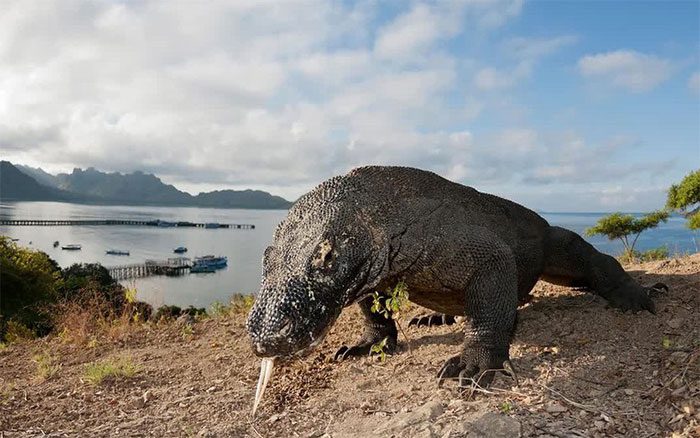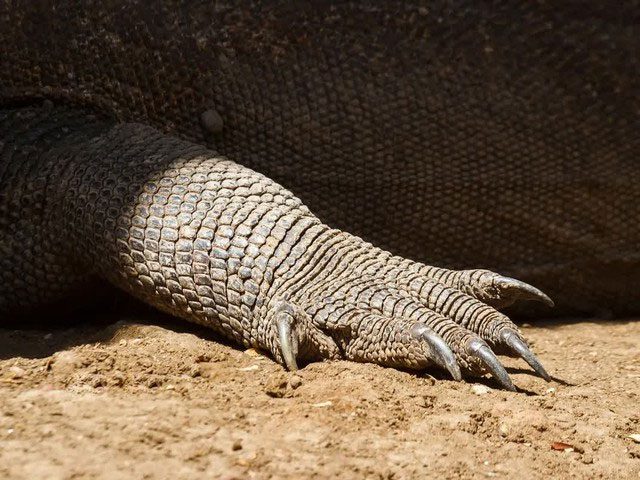The Komodo dragon, the largest reptile in the world, is not only a symbol of Indonesia’s wild nature but also an embodiment of danger and allure for visitors. Stories of risky encounters between humans and this giant lizard offer many lessons about respect and the conservation of nature.
Living Alongside a Dangerous Predator
Komodo National Park in Indonesia is the primary habitat of the Komodo dragon, spanning across islands such as Komodo, Rinca, and Flores. With lengths reaching up to 3 meters and weights exceeding 70 kg, the Komodo dragon is a formidable predator. Its strong jaws and sharp teeth enable it to attack prey swiftly and decisively.
Safina, a local guide at Komodo National Park, often shares insights with tourists about the hunting abilities and potential dangers of approaching this giant lizard. He does not hesitate to remind them of the horrifying stories that have occurred, from careless tourists to residents being ambushed right in their villages.
Nonetheless, tourists’ curiosity seems undeterred. Rachel Nuwer, a reporter for Smithsonian magazine, described the thrill of standing before the dragons in their natural habitat during her visit to Indonesia. She is not alone, as more and more people are willing to face danger to witness this giant lizard firsthand.

The Komodo dragon, the largest lizard in the world, has long captivated the attention of tourists and scientists alike due to its massive size and fearsome predatory instincts. However, behind the allure of thrilling encounters with this creature lies a concerning conservation narrative, as the population of Komodo dragons in the wild continues to decline.
Unforeseen Encounters
The danger of the Komodo dragon arises not only from its size and strength but also from its keen predatory instincts. Encounters with them, whether in the wild or at zoos, always carry risks.
At the Akron Zoo in Ohio, USA, in March 2023, two male Komodo dragons attacked each other after being accidentally locked in the same enclosure. When a staff member attempted to intervene, he was bitten multiple times by the larger dragon. Although the injuries were not serious, the incident prompted the zoo to review its safety protocols.
In Indonesia, in December 2020, a construction worker on Rinca Island was attacked by a dragon while working. The victim required emergency hospitalization, while images of a dragon confronting a construction truck at the site circulated on social media, drawing attention to a controversial development project called “Jurassic Park.”
Even more frightening stories arise from attacks in the wild. In 2017, a tourist from Singapore was bitten on the leg by a Komodo dragon while attempting to take a close-up photo. In 2007, an 8-year-old boy on Komodo Island was killed by a dragon while playing near his home. These incidents serve as stark reminders that, despite their allure, dragons remain dangerous predators that should not be underestimated.

A dragon walking along the coast overlooking some docks in Komodo National Park.
Challenges in Conservation
Despite the Komodo dragon remaining a symbol of wild nature in Indonesia, its population is significantly declining. According to estimates from the International Union for Conservation of Nature (IUCN), the number of adult Komodo dragons is now around 1,380, a drastic decrease from the 5,000 to 8,000 individuals recorded in the 1990s.
The primary cause is habitat loss due to rising sea levels and human land use. While Komodo National Park remains an important stronghold, many habitats of the dragons have been compromised by tourism development projects and construction.
One controversial project is the “Jurassic Park” resort on Rinca Island. The Indonesian government asserts that this project will boost the local economy without compromising the safety of the Komodo dragons. However, conservationists worry that construction and increased tourism activities could disrupt the natural habitat, causing stress and aggression in the dragons.
Gerardo Garcia, a biologist at Chester Zoo in the UK, likens the state of the Komodo dragon to a patient in urgent need of treatment. He emphasizes that without swift conservation actions, the future of this species will be severely threatened.

The foot of a Komodo dragon basking in the sunlight on Rinca Island.
The Future of the Komodo Dragon
The Komodo dragon is not only a symbol of Indonesia’s nature but also an essential part of the ecosystem on the islands where they live. Conservation efforts need to include strict control over tourism activities, protection of natural habitats, and raising community awareness about the importance of this species.
Each year, thousands of tourists visit Komodo National Park to witness the giant lizards in their natural habitat. While the allure of encounters with dragons is undeniable, it is crucial to prioritize safety, not just for humans but also for the dragons themselves.
The fate of the Komodo dragon serves as a clear warning about the impact of human activities on nature. Without decisive actions, future generations may only see this predator through stories, rather than witnessing them in the wild.


















































